The Timeless Appeal of Vintage Funeral Equipment
Vintage funeral equipment refers to historical tools, vehicles, and furnishings used in funeral services from the Victorian era through the mid-20th century. Here's what you need to know:
- Common types: Cooling tables, embalming instruments, church trucks, casket carriages, hearses, and chapel furniture
- Materials: Typically crafted from hardwoods (oak, cherry, mahogany), cast iron, brass, and porcelain
- Value range: $500-$6,000 depending on rarity, condition, and historical significance
- Where to find: Specialty auctions, estate sales, funeral industry Facebook groups, and dedicated dealers
- Popular collectors' items: Victorian cooling boards, early 20th century embalming machines, and classic funeral vehicles
The world of vintage funeral equipment combines craftsmanship, history, and a touch of the macabre. These artifacts tell the story of how we've honored our dead across generations, showcasing the evolution from home funerals with simple cooling boards to the sophisticated preparation and presentation equipment of early funeral homes. Unlike mass-produced modern alternatives, vintage pieces feature hand-carved details, quality materials, and designs that reflect the cultural attitudes toward death and remembrance of their era.
I'm Mortuary Cooler, a national-level mortuary cooler supplier with extensive experience evaluating, restoring, and sourcing vintage funeral equipment for both collectors and working funeral establishments across the United States. My background in modern refrigeration systems gives me unique insight into how historical preservation methods have evolved into today's technology.
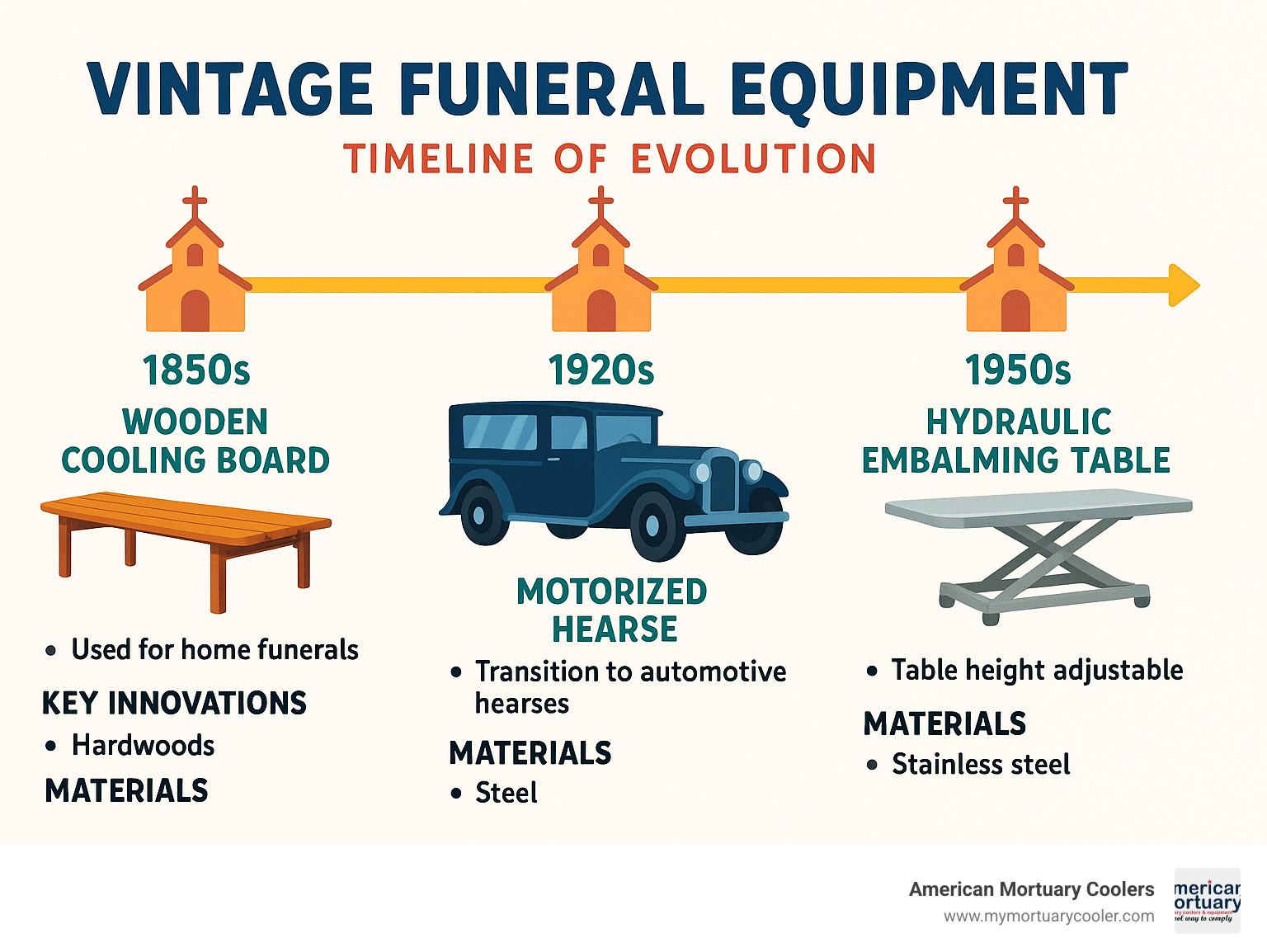
Vintage funeral equipment terms at a glance:
What Is Vintage Funeral Equipment? Definition, Types, and Historical Context
When we talk about vintage funeral equipment, we're referring to the specialized tools, furniture, and vehicles used in funeral services from about the 1850s through the 1970s. These fascinating artifacts tell the story of how death care evolved from intimate family affairs to the professional industry we know today.
The most treasured pieces typically come from the Victorian era through the early 20th century. During this golden age of craftsmanship, funeral equipment wasn't merely functional—it communicated dignity, respect, and often reflected the social standing of both the deceased and the funeral home itself.
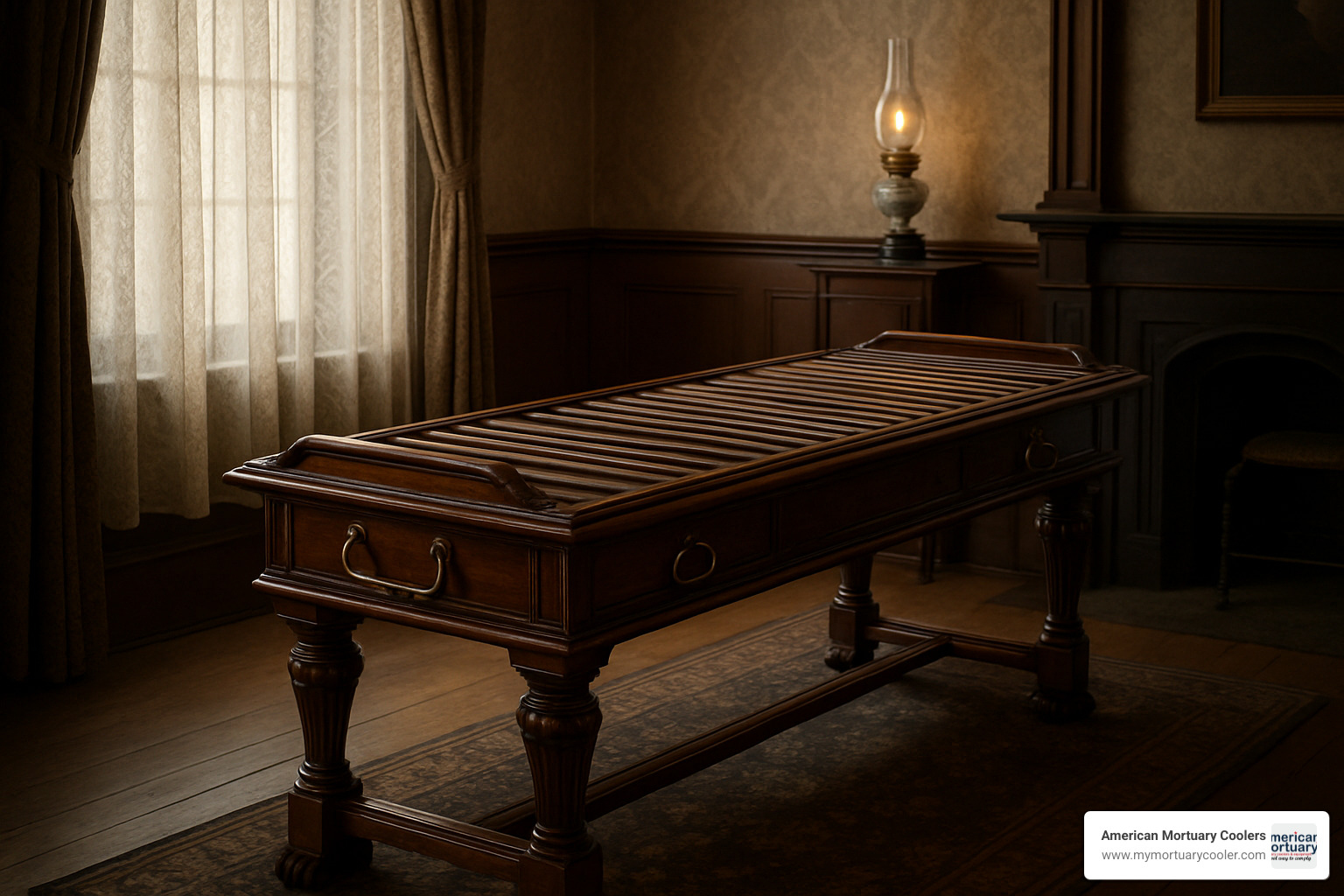
Take cooling tables, for instance. Before modern refrigeration changed everything, these wooden platforms held the deceased while ice placed underneath slowed decomposition. Some of the portable folding designs we've seen at auctions (selling for nearly $6,000!) included handles that allowed morticians to make house calls—a common practice when most people passed away at home.
More info about antique cooling tables
Key Categories of Vintage Funeral Equipment
At American Mortuary Coolers, we've watched interest grow in several distinct categories of vintage funeral equipment:
Cooling boards and tables started as simple wooden platforms but evolved to include clever drainage systems and decorative touches. Before refrigeration, these were essential for preservation.
Embalming machines and instruments transformed from basic gravity-fed fluid dispensers to sophisticated Duotrinic machines by the mid-20th century. The accompanying tools—arterial tubes, drainage devices, specialized forceps—have their own fascinating evolution.
Lowering devices used at gravesides started as simple rope and pulley systems before becoming elaborate mechanical marvels with safety features and smooth operation.
Funeral vehicles tell perhaps the most visible story of change—from ornate horse-drawn hearses with their glass panels and decorative elements to the first motorized versions that often kept much of that elaborate styling.
Chapel furniture created dignified settings for services, including specialized biers, church trucks (those wheeled platforms for moving caskets), neat torchiere lamps, and kneeling benches.
Cemetery tools beyond the lowering devices included specialized shovels, grave markers, and tent systems—practical items with their own unique design evolution.
Materials & Craftsmanship Hallmarks
The moment you handle a piece of vintage funeral equipment, the quality immediately speaks to you. These weren't mass-produced items, but carefully crafted pieces made with exceptional materials:
Hardwoods like oak, cherry, and mahogany were favorites for casket biers, church trucks, and cooling boards. These weren't chosen randomly—each wood offered the perfect combination of durability, beauty, and ability to take a high polish.
Metals served both practical and decorative purposes. Cast iron provided sturdy bases for embalming tables, while brass was used for decorative elements and functional components. Wrought iron appeared in cemetery equipment and some vehicle parts, often showing remarkable handwork.
Glass panels, often beveled and sometimes etched with designs, adorned hearses and display cases, adding a touch of elegance.
Porcelain enamel surfaces on embalming tables and preparation room equipment offered both sanitary conditions and visual appeal—practical yet beautiful.
Leather padding on church trucks and preparation tables provided both comfort and dignity.
The craftsmanship details still amaze us today—hand-carved decorative elements, mortise and tenon joinery in wooden pieces, hand-forged metal components. Even utilitarian items received meticulous attention. The Versailles Casket Bier, with its hand-carved corner posts and decorative grill work, would be prohibitively expensive to produce today.
How Historical Funeral Practices Shaped Equipment
The evolution of vintage funeral equipment perfectly mirrors how funeral practices changed over time:
When most people died at home, portable equipment was essential. Those folding cooling tables with handles let morticians prepare bodies right in the family parlor. Early embalming kits were designed to be carried to homes like doctor's bags.
Before chemical embalming became widespread, ice preservation was standard practice. This necessitated cooling tables with smart drainage systems—some even featured specialized compartments for ice placement.
The era of horse-drawn transportation influenced hearse design in practical ways—high driver's seats, carefully balanced weight distribution, and decorative elements visible from a distance during processions.
Rural funeral directors faced different challenges than their city counterparts. Their equipment often needed to be more versatile and portable, serving scattered communities across greater distances. Meanwhile, urban funeral establishments could invest in larger, more specialized stationary equipment.
As deaths gradually moved from homes to hospitals, and preparation shifted to dedicated funeral establishments, equipment evolved to become larger, more specialized, and less portable.
In our work at American Mortuary Coolers, we've traveled from Johnson City, Tennessee to Los Angeles, California, and everywhere in between. These journeys have shown us fascinating regional variations in vintage equipment design—each telling the story of how different communities honored their dead.
Sourcing and Authenticating Vintage Funeral Equipment: Where to Look and What to Ask
Finding genuine vintage funeral equipment is a bit like going on a treasure hunt - these specialized items rarely show up in your typical antique mall or Sunday flea market. Instead, you'll need to venture into more specific territories to uncover these historical pieces.
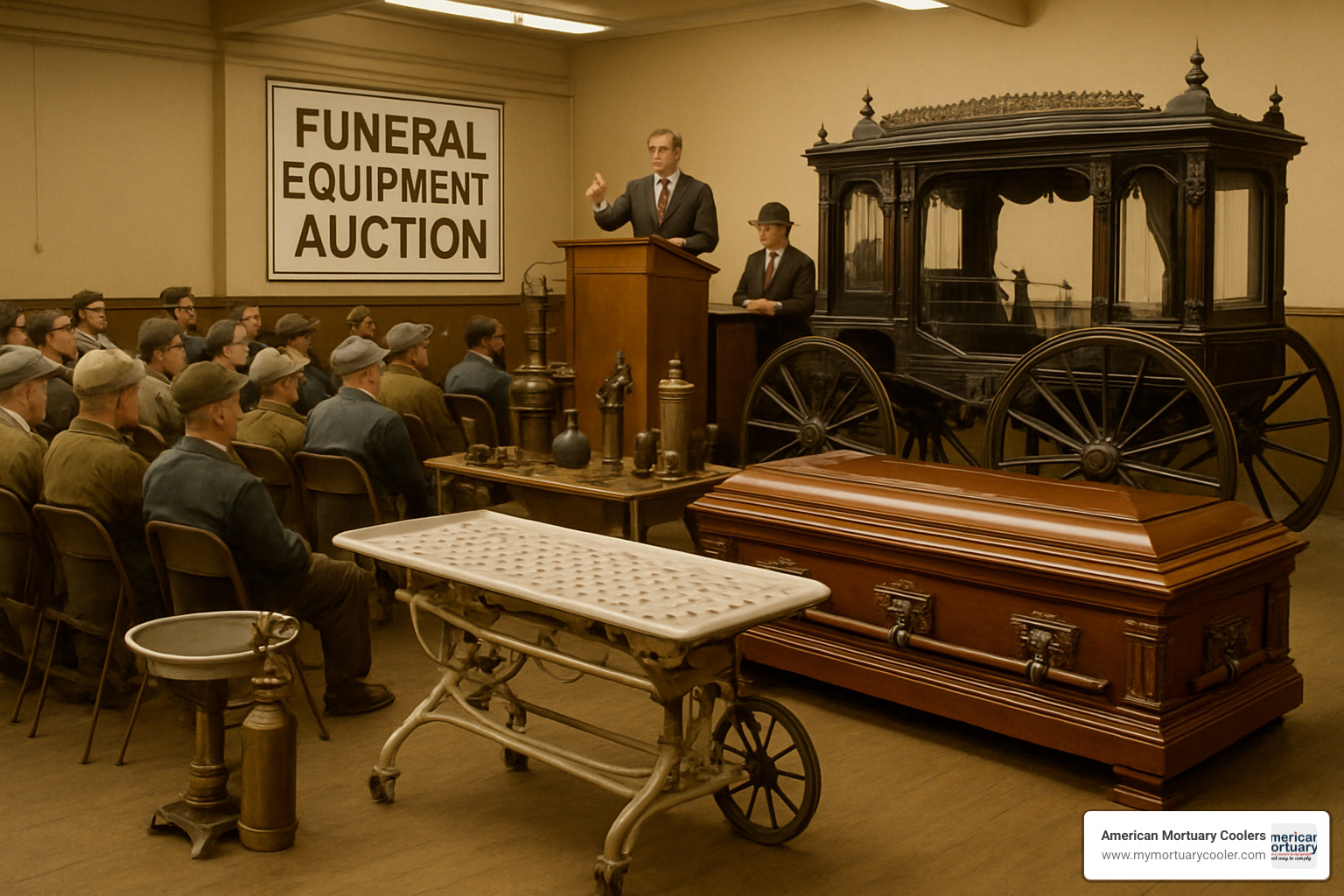
In my years helping funeral directors source both modern and vintage equipment, I've found that the most reliable places to find these treasures include estate sales of closing funeral homes, where generations of accumulated tools and furniture often become available all at once. These sales can be goldmines, offering everything from century-old cooling tables to mid-century church trucks.
Specialty dealers also exist in this niche market, though they rarely maintain physical storefronts. Instead, they operate through networks built over decades of industry connections. One funeral director in Michigan told me he found his prized 1930s embalming table through a dealer who specialized exclusively in funeral antiques - a connection he made at a state funeral directors' convention.
Online marketplaces have revolutionized the hunt for vintage funeral equipment. eBay's dedicated "Mortuary Supplies" category (#88743) consistently features both modern and vintage pieces. Meanwhile, Facebook groups like "Morticians Marketplace" have created vibrant communities where funeral professionals directly connect with collectors and other directors.
When evaluating a potential purchase, always ask about its provenance: Which funeral home used it? For how long was it in service? Has it been modified from its original design? For mechanical items like lowering devices or embalming machines, do all the moving parts still function as intended? And perhaps most importantly for items that had contact with the deceased - has it been properly sanitized?
Antique Embalming Tables: A Collector's Buying Guide
Online Marketplaces and Dealer Networks
The digital age has been a blessing for those seeking vintage funeral equipment, creating specialized spaces where these unique items regularly appear.
Vintage Funeral Hearse might be based in the UK, but they've become a global resource for classic funeral vehicles. They occasionally feature truly exceptional finds - like their recent listing of a 1920s Guy Funeral Hearse that was reportedly the only surviving example of its kind worldwide. While shipping costs can be substantial, serious collectors often find the investment worthwhile for truly rare specimens.
Mortuary Supplies on eBay offers a constantly rotating inventory that spans both centuries and continents. Just last month, I helped a client identify an authentic Victorian cooling table listed there for just under $6,000 - a fair price considering its excellent condition and complete original hardware.
Facebook has become surprisingly central to this market. Groups like "Morticians Marketplace" function as informal classified sections for the industry. A funeral director in Texas recently shared with me how he'd listed a 1940s church truck on the group and received five serious inquiries within hours - all from working funeral homes looking to incorporate vintage elements into their services.
I've also noticed a growing trend of funeral homes bypassing middlemen entirely. Many established firms with excess equipment simply list these items directly through industry publications or regional word-of-mouth networks. Building relationships with funeral directors, particularly in areas like the Midwest and Northeast where many funeral homes have operated continuously for generations, can lead to finding pieces that haven't been available on the open market for decades.
Red Flags & Authentication Tips for Buyers
When you're investing in vintage funeral equipment, knowing how to spot potential problems can save you from costly mistakes.
Be particularly wary of reproductions masquerading as originals. The market for vintage casket carriages has become so robust that some manufacturers now produce "vintage-style" models that can be difficult to distinguish from genuine antiques. Look closely at welding techniques, fastener styles, and materials - modern productions often use contemporary methods that weren't available when the original pieces were made.
Excessive restoration can also diminish both authenticity and value. While some restoration is expected and appropriate, pieces that have been completely refinished may have lost valuable original features and the natural patina that collectors prize. One funeral director I know passed on a seemingly perfect cooling table because the pristine finish revealed it had been completely stripped and refinished, removing much of its historical character.
Original hardware is crucial to a piece's authenticity and value. When examining church trucks or casket biers, check that handles, hinges, and decorative elements match the age and style of the piece. Replacements with modern equivalents significantly reduce both authenticity and value.
For the best authentication results:
Request detailed photos of maker's marks, hardware construction, and wear patterns before purchasing, especially for online transactions. These details often reveal more about authenticity than general appearance.
Cross-reference with historical catalogs whenever possible. Companies like FERNO have produced funeral equipment for decades with distinct model numbers and features that can be verified.
Verify measurements against historical standards, as dimensions often reveal authenticity. Pre-1940s cooling tables, for instance, were typically shorter than modern versions to accommodate the average height of that era.
Consider third-party appraisal for significant investments over $1,000, particularly for rare or unusual pieces where comparables may be difficult to find.
Typical Price Ranges & Current Market Trends
The market for vintage funeral equipment varies widely based on several factors, with condition and rarity driving the highest premiums.
Authentic Victorian-era cooling boards in excellent condition now regularly command $5,000-$6,000. Their scarcity and historical significance have made them particularly desirable to both collectors and upscale funeral establishments looking to showcase their heritage.
Vintage pallbearer carriages typically sell in the $3,875-$4,275 range, which interestingly is comparable to new production models. The difference is that the vintage pieces often feature craftsmanship details that would be prohibitively expensive to reproduce today.
Cemetery equipment like antique lowering devices ranges from $2,500 for basic models to $5,600 for complete systems with placer arms. Their mechanical nature means condition and functionality significantly impact value.
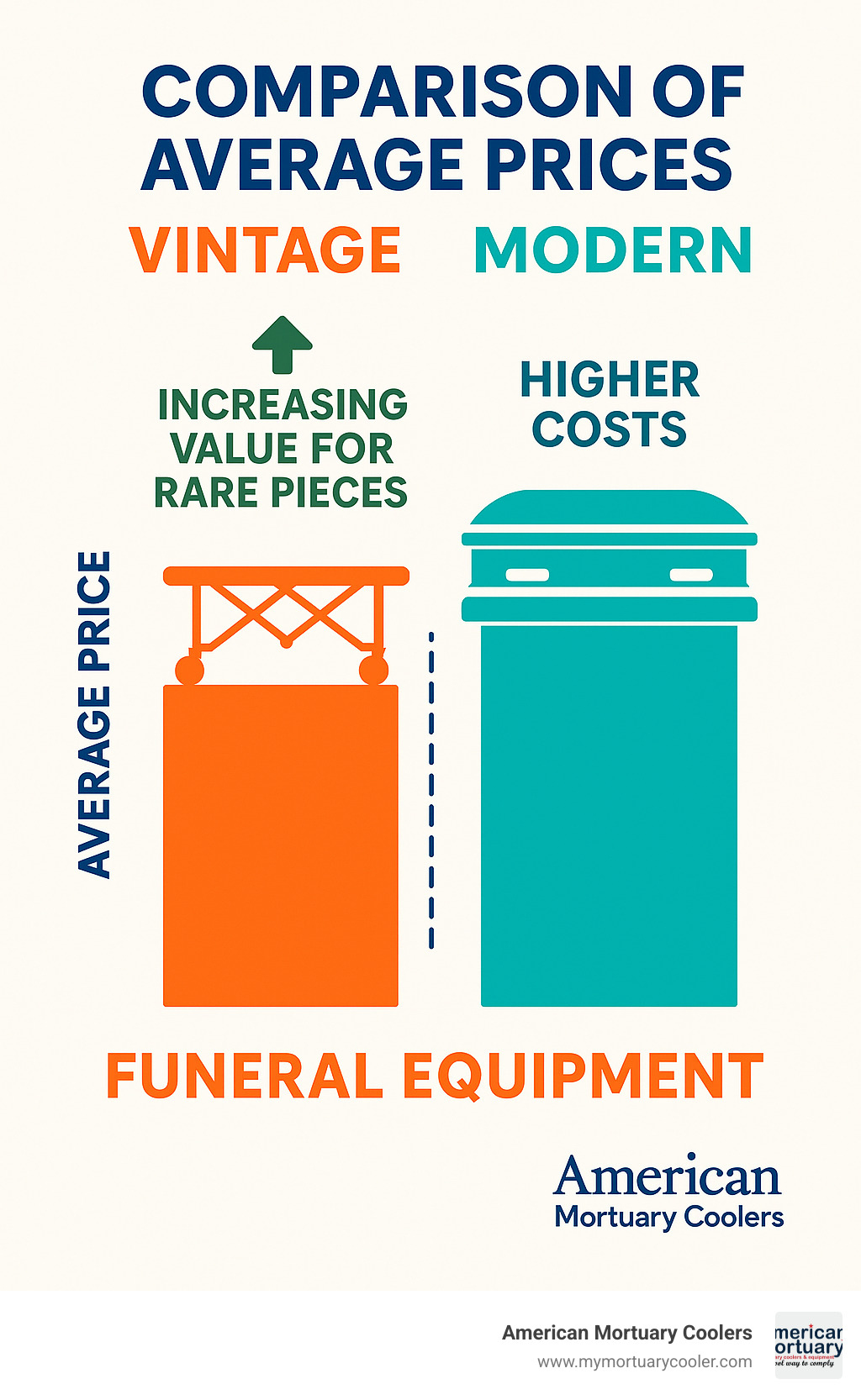
Classic hearses show the widest price variation of any category. Vehicles needing restoration might start around $15,000, while fully restored examples from prestigious manufacturers can exceed $50,000. One funeral director in Pennsylvania recently shared that his restored 1936 Packard hearse had been appraised at $65,000 - more than triple what he paid for it in unrestored condition just five years ago.
Church trucks from recognized manufacturers like FERNO typically sell for $500-$1,500 depending on condition. These practical pieces remain popular because they can still be used in modern funeral services while adding a touch of heritage.
At American Mortuary Coolers, we've observed several important market trends developing. There's a growing scarcity premium as funeral homes modernize and fewer vintage pieces remain in circulation. Condition sensitivity has increased dramatically, with perfect or near-perfect condition commanding significant premiums over similar pieces showing damage or wear.
We've also noticed strong preference for complete sets or systems. A matched pair of church trucks, for instance, will typically sell for more than twice the price of a single truck. Regional variation continues to influence prices, with generally higher values in the Northeast and Pacific regions compared to the Midwest and Southeast.
Restoring, Maintaining, and Legally Owning Vintage Funeral Equipment
Owning vintage funeral equipment isn't just about finding beautiful historical pieces—it's about becoming a caretaker of funeral history. Whether you're displaying these treasures or incorporating them into modern services, proper restoration and maintenance ensures these pieces will continue telling their stories for generations to come.
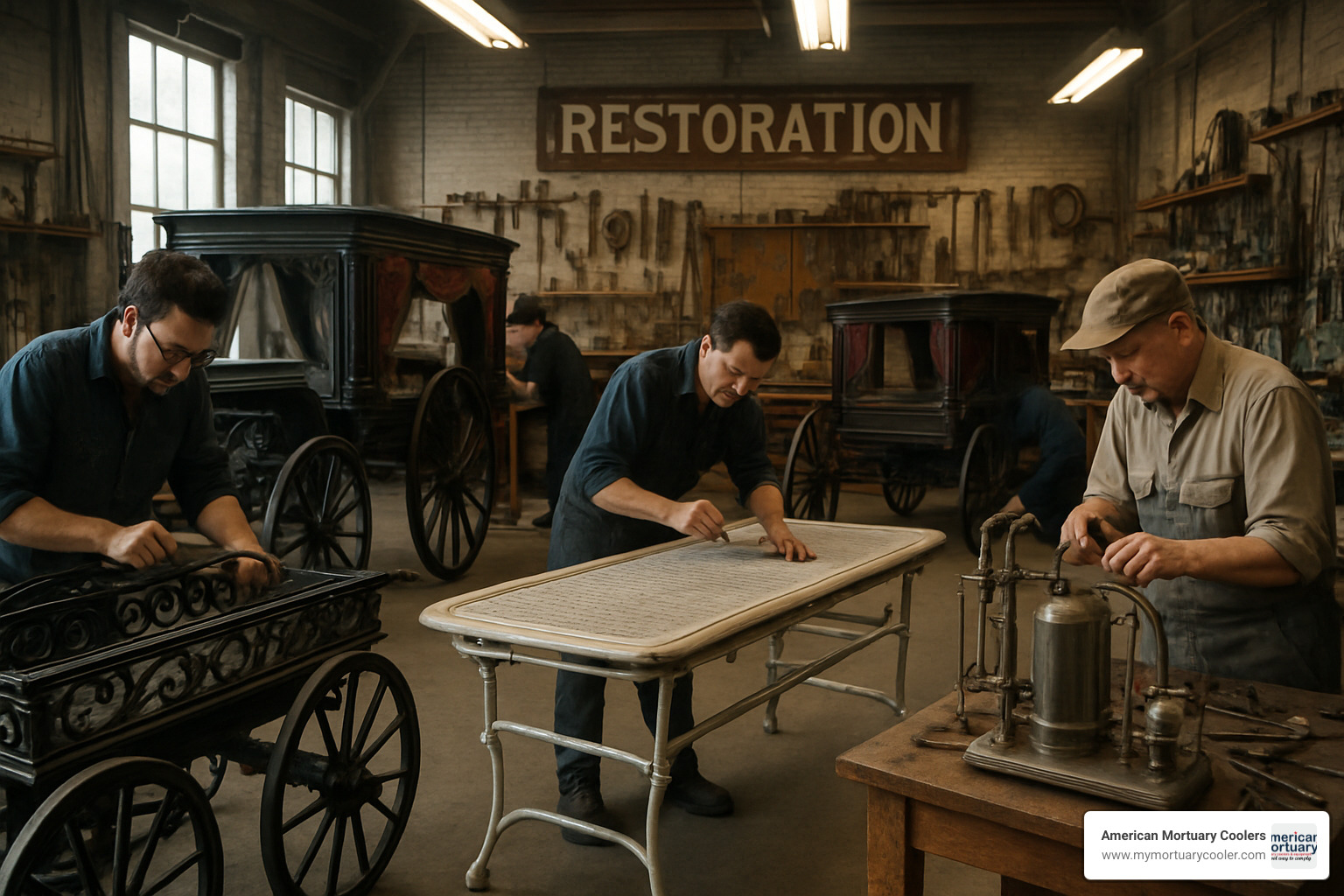
At American Mortuary Coolers, we've guided countless clients through the restoration journey, from Chicago's historic funeral homes to Atlanta's boutique memorial services. We've seen how these pieces transform with proper care—and the pitfalls that can damage irreplaceable artifacts.
Basic Restoration Steps & Common Challenges
Bringing a piece of vintage funeral equipment back to its former glory is a bit like detective work. You're uncovering history with every layer of old finish you remove.
Start by thoroughly documenting everything—take photos from every angle before you touch a thing. This creates a record of the original condition and helps guide your restoration. For funeral equipment especially, proper disinfection isn't just good practice—it's essential safety. Many pieces have contacted biological materials, even if decades ago.
The real artistry comes in the details. When working on a Victorian cooling table recently, one of our Tennessee clients finded three different layers of finish, each telling a story about when and how the piece had been maintained. Preserving these stories while making the piece functional requires patience.
Wood repairs often present the biggest challenges—finding matching 100-year-old oak or replacing hand-carved elements isn't something you can solve with a quick trip to the hardware store. Metal components bring their own difficulties, particularly with cast iron pieces that may have developed hairline cracks over decades of use.
One of the most common questions we hear: "Should I refinish it completely or preserve the patina?" There's no single right answer. For display pieces, preserving original finishes often maintains higher value. For equipment returning to service, sometimes a complete refinish is necessary—just be sure to use period-appropriate materials.
Hardware often becomes the unexpected treasure hunt. Finding authentic brass handles for a 1920s church truck might require scouring specialty suppliers or salvaging parts from beyond-repair pieces. We've seen dedicated restorers create silicon molds of original hardware to cast replacements when originals simply can't be found.
Compliance, Safety, and Ethical Considerations
Owning vintage funeral equipment comes with responsibilities that extend beyond mere preservation. These pieces existed in a working environment with different standards than today.
If you're a funeral professional incorporating vintage pieces into your services, OSHA doesn't offer "historical exemptions." That beautiful antique lowering device needs to meet modern safety standards if you're actually using it at gravesides. This often means retrofitting with safety features while maintaining period appearance.
Biohazard concerns are real—even with pieces that have been out of service for decades. Proper sanitization isn't just about a quick wipe-down; it requires understanding what chemicals and processes will effectively clean without damaging historical materials. One Texas funeral director we work with finded that the porcelain embalming table he purchased still contained residue in hard-to-reach crevices, requiring specialized cleaning.
Load ratings present another safety consideration. That neat church truck might have been designed when caskets were consistently lighter than many modern equivalents. Testing and potentially reinforcing these pieces is crucial before putting them into service.
The ethical dimensions of collecting funeral artifacts deserve thoughtful consideration too. Some pieces have cultural or religious significance that might make their collection or display inappropriate without proper context. We always encourage our clients to research provenance and consider how to respectfully preserve and present these items.
Different regions interpret regulations differently. Our Pittsburgh clients face different regulatory frameworks than those in Los Angeles or Dallas. Always check local regulations, especially if you're planning to transport pieces across state lines or international borders.
Storage and Long-Term Care Best Practices
Proper storage is the unsung hero of vintage funeral equipment preservation. The most beautiful restoration can be undone by poor storage conditions.
Climate control isn't just a luxury—it's essential. Wood expands and contracts with humidity changes, potentially causing irreparable damage to joinery. Metal components can develop corrosion even in seemingly dry environments. Aim for consistent temperature (65-70°F) and moderate humidity (45-55%) for optimal preservation.
Sunlight is the silent destroyer of historical pieces. Even indirect UV exposure can fade finishes and weaken materials over time. Position pieces away from windows or use UV-filtering coverings when direct sunlight is unavoidable.
For pieces with moving parts—like the mechanisms in lowering devices or the hinges on church trucks—regular maintenance prevents bigger problems. A schedule of inspection, cleaning, and lubrication keeps everything working smoothly. One New York funeral director we work with has maintained the same vintage casket carriage for three generations simply through diligent quarterly maintenance.
Proper support during storage prevents warping and joint stress. Large flat pieces like cooling tables should never be stored leaning against walls for extended periods. Instead, create proper horizontal supports that distribute weight evenly.
Documentation becomes increasingly valuable over time. Keep detailed records of your piece's history, condition, and any restoration work performed. Future owners will thank you for this information, and it often increases the piece's value.
Don't overlook insurance for valuable items. Standard homeowner's or business policies rarely provide adequate coverage for specialized funeral antiques. We've seen too many collectors learn this lesson the hard way after damage or loss.
At American Mortuary Coolers, we've helped clients across all regions develop storage solutions that account for their local climate challenges—from the humidity of the Southeast to the dry conditions of the Rocky Mountains. With proper care, these historical treasures can continue sharing their stories for generations to come.
Bringing Vintage Funeral Equipment Into Modern Services
There's something magical about incorporating vintage funeral equipment into today's memorial services. It's like adding a touch of history and personality to what might otherwise be a standard ceremony. Across the country, from the historic streets of Columbia, South Carolina to the busy cityscape of Chicago, we're seeing families accept these timeless pieces to create more meaningful goodbyes.
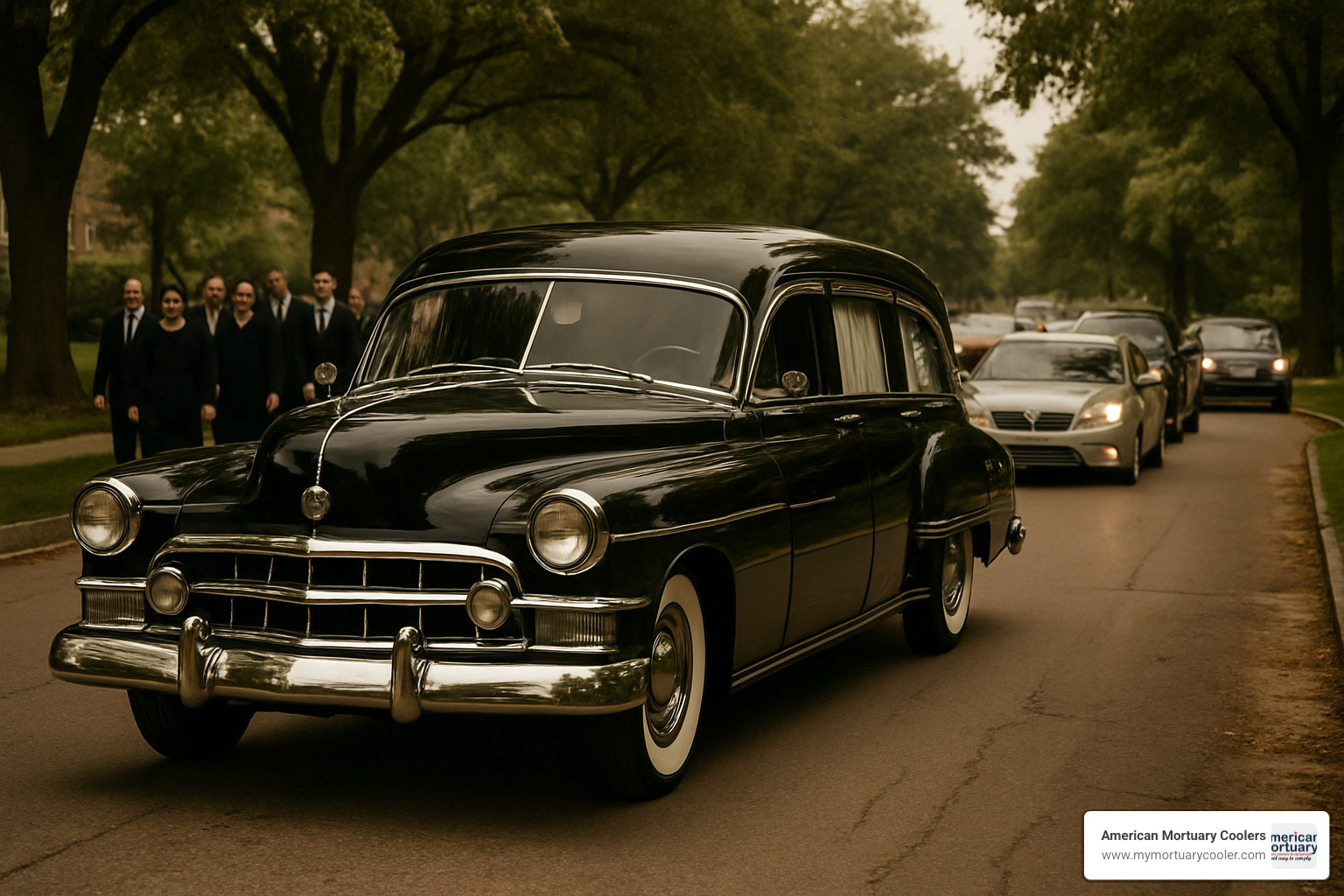
Modern families are increasingly searching for ways to make funeral services feel less cookie-cutter and more reflective of their loved one's unique life. Vintage funeral equipment offers that perfect bridge between honoring traditional practices while creating a visually distinctive experience that guests will remember long after the service ends.
Vintage Funeral Equipment for Stand-Out Memorial Experiences
When it comes to creating a truly memorable service, the details matter. A standard metal casket stand fades into the background, but place that same casket on a hand-carved Versailles bier with intricate detailing, and suddenly you've created a focal point that honors the deceased with dignity and visual impact.
The warm glow of vintage torchiere lamps creates an atmosphere that modern fluorescent lighting simply can't match. There's something about that gentle illumination that feels respectful and comforting during viewings.
We've helped funeral homes across the Southeast transform their spaces with vintage church trucks – those beautiful hardwood and brass casket carriages that add a ceremonial quality to the simple act of moving a casket. Families often comment on how much more dignified these movements feel compared to modern alternatives.
For those looking to make a statement during the procession, nothing turns heads like a classic hearse. Whether it's a stately 1920s model or a more distinctive 1970s design, these vehicles create conversation and connection. I'll never forget helping a family in the Midwest Region who used their grandfather's restored 1973 Ford Escort hearse for his final journey – it perfectly reflected his lifelong passion for classic cars.
Even simple elements like vintage register stands and announcement boards can lift the presentation of photographs and memorabilia, giving these precious memories the proper setting they deserve.
More info about funeral equipment shopping list
Combining Old and New Technologies
What I love most about working with vintage funeral equipment is finding clever ways to blend historical aesthetics with modern convenience. There's no rule that says you can't have the best of both worlds!
We recently helped a funeral home in Tennessee discreetly install LED lighting inside an antique bier. The gentle illumination highlighted the casket beautifully while remaining completely invisible to mourners. It's these thoughtful touches that can transform a traditional piece into something even more special.
For families who want music during processions, we've worked with restoration specialists to incorporate Bluetooth sound systems into vintage hearses. The speakers are carefully positioned to preserve the vehicle's historical integrity while providing clear, personalized music that means something to the family.
At American Mortuary Coolers, our specialty is creating modern refrigeration systems housed within cabinetry that maintains a traditional appearance. A funeral home shouldn't have to choose between efficient operation and maintaining a dignified, classic aesthetic.
We've even seen funeral directors get creative with digital displays, tastefully integrating them with vintage announcement stands to create memorial slideshows that blend the old with the new. The possibilities are endless when you approach these adaptations with respect for the original craftsmanship.
The key is finding that sweet spot – updating the functionality without compromising what makes these pieces special in the first place. Our team in Johnson City takes particular pride in creating these custom solutions that honor both tradition and practicality.
Case Studies & Notable Examples of Vintage Funeral Equipment
The stories behind these pieces are often as fascinating as the equipment itself.
Consider the journey of the 1920s Guy Lorry Hearse – a vehicle that began its life as a humble Australian farm truck before being transformed into an neat funeral carriage. Now marketed as the only one of its kind worldwide, it offers families a truly one-of-a-kind option for their loved one's final journey. I've found that agricultural families in particular connect with its farming heritage, seeing it as the perfect tribute for someone who spent their life working the land.
The value of these pieces continues to climb, too. Just recently, a vintage mortician's cooling table sold for nearly $6,000. What made it especially valuable was its portable folding design with a handle – a practical feature from an era when morticians routinely made house calls because most people died at home. More than just a collector's item, it's a tangible piece of funeral service history.
I smile when I think about the Texas funeral director who purchased a complete set of embalming equipment for a funeral home he never ended up opening. Rather than letting these beautiful pieces gather dust, he connected with the "Morticians Marketplace" Facebook group and found eager buyers for each item. It's a testament to both the active market for vintage funeral equipment and how specialized online communities have made it easier to connect these pieces with people who appreciate them.
One of my favorite success stories comes from a funeral home in the Northeast that incorporated a complete set of Victorian-era chapel furniture into their main visitation room. The ornate biers, neat torchiere lamps, and traditional kneeling benches created such a distinctive atmosphere that families now specifically request the "heritage room" for traditional services. What began as a preservation effort became a marketing advantage that sets them apart from competitors.
These pieces aren't just beautiful artifacts – they're tools that help create more meaningful memorial experiences. In a world of increasing standardization, there's something profoundly human about incorporating elements with history, craftsmanship, and character into our final farewells.
Frequently Asked Questions about Vintage Funeral Equipment
Collecting and working with vintage funeral equipment brings up some common questions. Let's address the ones we hear most often from both collectors and funeral professionals across the country.
Is it Legal to Use Antique Embalming Tools Today?
You can absolutely own antique embalming instruments as fascinating collectibles, but using them professionally? That's where things get complicated.
Modern funeral professionals need to use equipment that meets current health and safety standards. Those beautiful brass and glass embalming pumps from the 1920s might look impressive in a display case, but they simply don't meet today's OSHA regulations or state health department requirements. Many vintage instruments contain materials now considered hazardous or lack essential safety features required in modern preparation rooms.
While no federal laws specifically prohibit owning these historical tools as collectibles, some states have their own regulations about possessing medical instruments. We've worked with collectors from Tennessee to California and found the rules can vary significantly by location. When in doubt, a quick check with your local regulatory authorities can prevent headaches down the road.
How Do I Transport a Vintage Hearse Across State Lines?
Moving a classic hearse across state lines requires more planning than your average vehicle transport. From our experience helping clients across our service areas, here's what you need to know:
First, make sure your paperwork is in order. You'll need proper vehicle registration (either standard passenger vehicle plates or, in some states, special funeral vehicle registration) and comprehensive documentation including your bill of sale and any historical records that establish the vehicle's provenance.
Insurance coverage deserves special attention. Standard auto policies often don't adequately protect these unique vehicles. We recommend specialized classic car insurance with clear provisions for interstate travel. One collector in South Carolina learned this lesson the hard way when his standard policy wouldn't cover damage to the vintage glass panels during transport.
For non-operational hearses, enclosed transport is worth the extra cost. Those neat glass panels and ornate finishes deserve protection from road debris and weather. If you're driving the vehicle yourself, research your route carefully – some states have specific requirements for funeral vehicles entering their jurisdiction, even when they're not being used for funeral services.
What Should I Budget for Restoring a Vintage Cooling Table?
When clients ask about restoration costs for a vintage cooling table, I typically suggest budgeting between $1,200 and $3,500, depending on the table's condition and your restoration goals.
The first expense – and this is non-negotiable – is professional disinfection and cleaning, typically costing $300-$500. These tables were working equipment in contact with the deceased, so proper sanitization is essential before any other work begins.
After that, costs break down into several categories: structural repairs to wood components ($400-$900), refinishing ($300-$800), hardware restoration or replacement ($200-$500), and repairs to drainage systems if applicable ($150-$400). Don't forget to factor in transportation costs to and from restoration specialists, which can add another $150-$400 depending on distance.
Several factors can push your costs toward the higher end of these ranges. Rare woods requiring specialized matching, missing original hardware that requires custom fabrication, or items with significant historical value that demand conservation-grade restoration techniques all increase the final price tag.
We've worked with funeral homes from Johnson City to Los Angeles on restoration projects, and our consistent advice is to budget generously. Quality restoration isn't the place to cut corners, especially when dealing with potential biohazard issues. The investment pays off in both the item's longevity and its safety for display or use.
More info about morgue coolers supplier
Conclusion
The world of vintage funeral equipment offers a fascinating glimpse into the evolution of funeral practices and the craftsmanship of bygone eras. Whether you're a collector, a funeral professional, or simply interested in funeral history, these artifacts connect us to traditions of dignity and care that span generations.
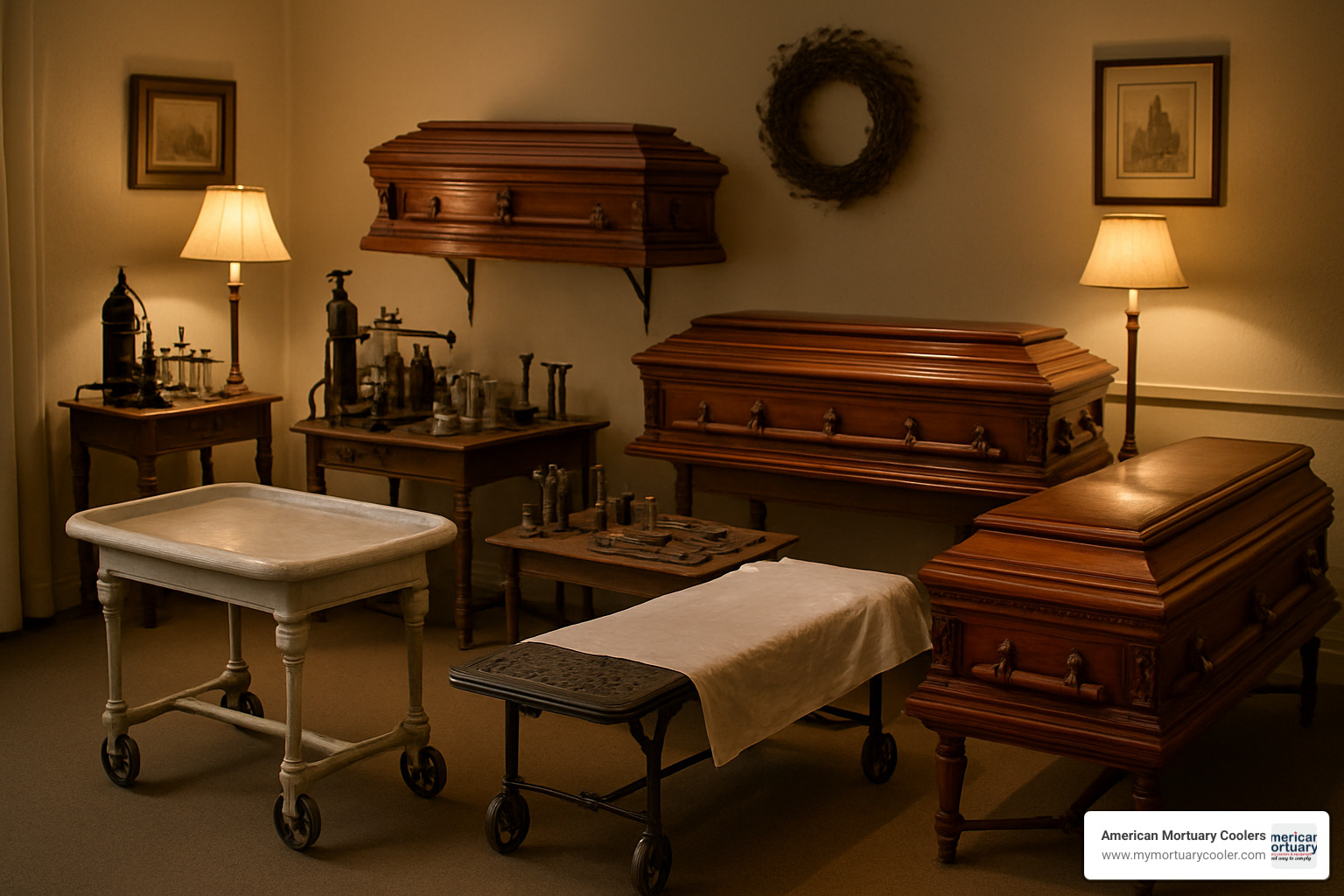
There's something truly special about holding a piece of funeral history in your hands. Each cooling table, church truck, or vintage hearse tells a story – not just about how we've cared for our dead, but about the craftspeople who created these items with such attention to detail and respect for their purpose.
Finding and authenticating these treasures isn't always easy. It takes patience, knowledge, and sometimes a bit of detective work to separate the genuine articles from reproductions. When you do find that perfect piece – whether it's a Victorian cooling board with its original hardware or a 1920s casket carriage with hand-carved details – the reward is worth the hunt.
For funeral homes, incorporating vintage funeral equipment into modern services creates experiences families won't forget. When personalization matters more than ever, these heritage pieces offer something truly distinctive. I've seen families' eyes light up when they see their loved one displayed on a beautifully restored antique bier instead of a standard modern table. These moments of connection to tradition can bring unexpected comfort during difficult times.
The investment value of these pieces continues to grow too. As fewer examples remain in circulation, prices for well-preserved items steadily climb. What was once considered outdated equipment is now recognized as irreplaceable craftsmanship that simply can't be duplicated with today's manufacturing methods.
Here at American Mortuary Coolers, we have a foot in both worlds – appreciating the beauty and history of vintage funeral equipment while also crafting modern refrigeration solutions that meet today's needs. Our nationwide presence means we understand the regional variations in both historical pieces and contemporary requirements. From our home base in Johnson City, Tennessee to our clients in Los Angeles, California, we help funeral professionals find the right balance between honoring tradition and embracing innovation.
For those interested in blending old and new, we offer consultation services to determine what approach works best for your specific situation. Our custom mortuary coolers can even be designed with historical aesthetics in mind – modern technology discreetly housed in cabinetry that complements your vintage pieces.
More info about morgue coolers supplier
Whether these treasures end up in museums, funeral home heritage rooms, or actively used in contemporary services, vintage funeral equipment deserves the care and respect its craftsmanship commands. These pieces aren't just antiques – they're tangible connections to how we've honored our dead for generations. In preserving them, we preserve an important chapter in the story of how we care for each other, even after death.